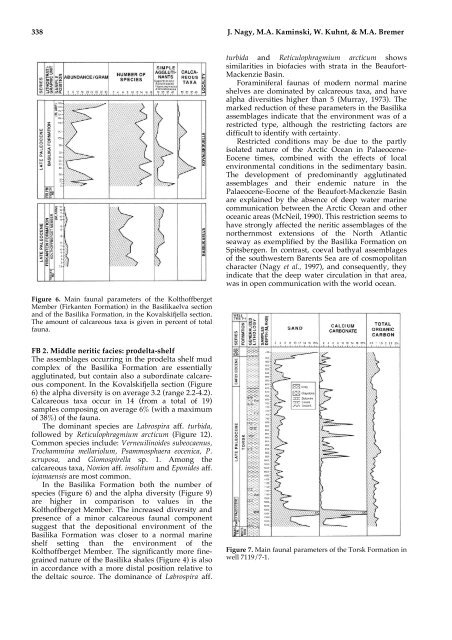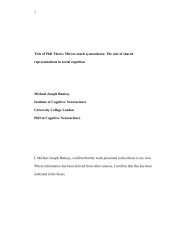Agglutinated foraminifera from neritic to bathyal facies in the ...
Agglutinated foraminifera from neritic to bathyal facies in the ...
Agglutinated foraminifera from neritic to bathyal facies in the ...
You also want an ePaper? Increase the reach of your titles
YUMPU automatically turns print PDFs into web optimized ePapers that Google loves.
338 J. Nagy, M.A. Kam<strong>in</strong>ski, W. Kuhnt, & M.A. Bremer<br />
Figure 6. Ma<strong>in</strong> faunal parameters of <strong>the</strong> Kolthoffberget<br />
Member (Firkanten Formation) <strong>in</strong> <strong>the</strong> Basilikaelva section<br />
and of <strong>the</strong> Basilika Formation, <strong>in</strong> <strong>the</strong> Kovalskifjella section.<br />
The amount of calcareous taxa is given <strong>in</strong> percent of <strong>to</strong>tal<br />
fauna.<br />
FB 2. Middle <strong>neritic</strong> <strong>facies</strong>: prodelta-shelf<br />
The assemblages occurr<strong>in</strong>g <strong>in</strong> <strong>the</strong> prodelta shelf mud<br />
complex of <strong>the</strong> Basilika Formation are essentially<br />
agglut<strong>in</strong>ated, but conta<strong>in</strong> also a subord<strong>in</strong>ate calcareous<br />
component. In <strong>the</strong> Kovalskifjella section (Figure<br />
6) <strong>the</strong> alpha diversity is on average 3.2 (range 2.2-4.2).<br />
Calcareous taxa occur <strong>in</strong> 14 (<strong>from</strong> a <strong>to</strong>tal of 19)<br />
samples compos<strong>in</strong>g on average 6% (with a maximum<br />
of 38%) of <strong>the</strong> fauna.<br />
The dom<strong>in</strong>ant species are Labrospira aff. turbida,<br />
followed by Reticulophragmium arcticum (Figure 12).<br />
Common species <strong>in</strong>clude: Verneuil<strong>in</strong>oides subeocaenus,<br />
Trochamm<strong>in</strong>a mellariolum, Psammosphaera eocenica, P.<br />
scruposa, and Glomospirella sp. 1. Among <strong>the</strong><br />
calcareous taxa, Nonion aff. <strong>in</strong>solitum and Eponides aff.<br />
iojamaensis are most common.<br />
In <strong>the</strong> Basilika Formation both <strong>the</strong> number of<br />
species (Figure 6) and <strong>the</strong> alpha diversity (Figure 9)<br />
are higher <strong>in</strong> comparison <strong>to</strong> values <strong>in</strong> <strong>the</strong><br />
Kolthoffberget Member. The <strong>in</strong>creased diversity and<br />
presence of a m<strong>in</strong>or calcareous faunal component<br />
suggest that <strong>the</strong> depositional environment of <strong>the</strong><br />
Basilika Formation was closer <strong>to</strong> a normal mar<strong>in</strong>e<br />
shelf sett<strong>in</strong>g than <strong>the</strong> environment of <strong>the</strong><br />
Kolthoffberget Member. The significantly more f<strong>in</strong>egra<strong>in</strong>ed<br />
nature of <strong>the</strong> Basilika shales (Figure 4) is also<br />
<strong>in</strong> accordance with a more distal position relative <strong>to</strong><br />
<strong>the</strong> deltaic source. The dom<strong>in</strong>ance of Labrospira aff.<br />
turbida and Reticulophragmium arcticum shows<br />
similarities <strong>in</strong> bio<strong>facies</strong> with strata <strong>in</strong> <strong>the</strong> Beaufort-<br />
Mackenzie Bas<strong>in</strong>.<br />
Foram<strong>in</strong>iferal faunas of modern normal mar<strong>in</strong>e<br />
shelves are dom<strong>in</strong>ated by calcareous taxa, and have<br />
alpha diversities higher than 5 (Murray, 1973). The<br />
marked reduction of <strong>the</strong>se parameters <strong>in</strong> <strong>the</strong> Basilika<br />
assemblages <strong>in</strong>dicate that <strong>the</strong> environment was of a<br />
restricted type, although <strong>the</strong> restrict<strong>in</strong>g fac<strong>to</strong>rs are<br />
difficult <strong>to</strong> identify with certa<strong>in</strong>ty.<br />
Restricted conditions may be due <strong>to</strong> <strong>the</strong> partly<br />
isolated nature of <strong>the</strong> Arctic Ocean <strong>in</strong> Palaeocene-<br />
Eocene times, comb<strong>in</strong>ed with <strong>the</strong> effects of local<br />
environmental conditions <strong>in</strong> <strong>the</strong> sedimentary bas<strong>in</strong>.<br />
The development of predom<strong>in</strong>antly agglut<strong>in</strong>ated<br />
assemblages and <strong>the</strong>ir endemic nature <strong>in</strong> <strong>the</strong><br />
Palaeocene-Eocene of <strong>the</strong> Beaufort-Mackenzie Bas<strong>in</strong><br />
are expla<strong>in</strong>ed by <strong>the</strong> absence of deep water mar<strong>in</strong>e<br />
communication between <strong>the</strong> Arctic Ocean and o<strong>the</strong>r<br />
oceanic areas (McNeil, 1990). This restriction seems <strong>to</strong><br />
have strongly affected <strong>the</strong> <strong>neritic</strong> assemblages of <strong>the</strong><br />
nor<strong>the</strong>rnmost extensions of <strong>the</strong> North Atlantic<br />
seaway as exemplified by <strong>the</strong> Basilika Formation on<br />
Spitsbergen. In contrast, coeval <strong>bathyal</strong> assemblages<br />
of <strong>the</strong> southwestern Barents Sea are of cosmopolitan<br />
character (Nagy et al., 1997), and consequently, <strong>the</strong>y<br />
<strong>in</strong>dicate that <strong>the</strong> deep water circulation <strong>in</strong> that area,<br />
was <strong>in</strong> open communication with <strong>the</strong> world ocean.<br />
Figure 7. Ma<strong>in</strong> faunal parameters of <strong>the</strong> Torsk Formation <strong>in</strong><br />
well 7119/7-1.
















